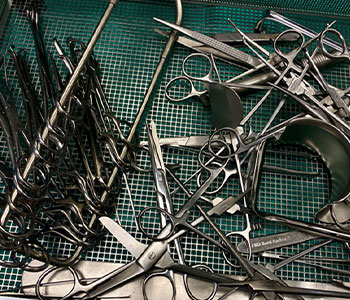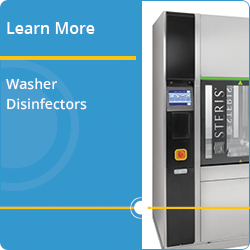STANDARDS AND GUIDELINES FOR LOADING WASHER RACKS
While standards and guidelines around washer/disinfectors exist, many do not specify how to load a washer rack beyond instructing users not to overload it. Key standards that mention washer/disinfector loading include ANSI/AAMI ST79:2017 & 2020 Amendments, the CSA Z314-18 National Standard of Canada, and the EN ISO 15883 series used primarily in Europe. The Healthcare Sterile Processing Association (HSPA) also provides guidance in the 9th edition of the Sterile Processing Technical Manual, guiding technicians on proper preparation and providing tips for proper loading of racks.
While these resources can provide useful information on best practices, these standards do not provide step-by-step instructions on how to load a washer rack
properly, but for good reason. Each washer load will be unique, with varying instruments and accessories from multiple sets. This variability leaves technicians responsible for determining how to
best arrange the devices for the load they're working on. Understanding best practices is the first step to proper washer rack loading.
TIPS FOR MEDICAL WASHER RACK LOADING SUCCESS
When technicians load a washer rack, various instruments from different sets are loaded onto the same washer rack load. Best practices for loading washer racks involve:
Preparing Instruments
- Remove items that impede washing – Items like chemical indicators, container filters, tray liners, and paper items should not be included in washer loads as they can clog the washer recirculation system. Solid rubber and silicone mats should also be removed to allow water to flow freely through all instrument sets and levels of the washer rack. Silicone mats should be washed separately from instrument sets.
- Instruments should be disassembled per the device IFU, and all small parts should be removed and placed into a closed basket designed for use in a washer/disinfector. Be sure to follow all cleaning instructions provided by the instrument manufacturer.
- Hinged instruments must be opened to access the box lock so the cleaning solution can reach all crevasses
- Multi-level trays should be opened and separated to be washed as individual trays and all lids removed
Loading the Instruments Into Washer Racks

- Load from the bottom up – Placing heavier and larger items on the bottom shelves and lighter items on top. Loading from the bottom up helps to ensure stability and proper chemistry exposure.
- Avoid "shadowing" to ensure exposure of all instrument parts to cleaning and disinfection processes. Using trays with mesh bottoms and sides allows fluids to reach all surfaces and drain away effectively.
- Use positioning accessories – Accessories such as instrument stringers or washer rack inserts, to help position the instruments or utensils. These aids can also prevent instruments and utensils from shifting during the cleaning process.
- Don't overload racks - Overloading racks can prevent effective cleaning and may require re-washing of instruments. Spray arms of the washer and washer rack should be able to move freely. Instruments that are sticking up or sticking out through the mesh basket must not impede the washer spray arms. Ensure enough space between items for the cleaning solution to reach all surfaces.
- Consider set weights – A tray with more than 25 lbs. would be challenging to sterilize in steam sterilization properly - if it's too heavy for the sterilizer, why would this work for the washer? This simple rule can help avoid overloading too many instruments into one mesh tray. Washer/Disinfectors also have total cycle weight limits, often around 130 lbs. for the complete load, including racks and accessories.

- Connect available hoses to lumened and cannulated devices – Some technicians may be unaware these hoses could be connected to help flush cleaning solutions through lumened devices such as suction tubes. This step helps ensure the removal of debris from the interior of these devices and helps prevent the need to repeat the decontamination reprocess.
Additional Considerations for Washer Racks
- Loaner trays must be separated – Although loaner sets should be kept together, many of these multi-tray sets are layered and must be separated. Remember, all parts of devices should be accessible by washer solution and spray arms.
- Regular maintenance of racks is crucial for optimal performance – Inspect and maintain racks regularly, checking spray arms for free rotation and removing any debris that may impede cleaning. Ensure that tubing, filters, and any other components requiring replacement at regular intervals are part of the preventative maintenance schedule.

Before putting a washer rack into service for the day, running an empty rack on a cycle with a VERIFY® All Clean Test Washer Indicator tests the performance of your automated washer/disinfector process and instrument cleaning chemistry functionality to help ensure cleaning is done effectively.
For example, STERIS was called into a facility over concerns with washer performance – the VERIFY All Clean Washer Indicator was failing. Upon inspection, the spray head of the washer rack had not been properly cleaned. After removing the spray head and cleaning, the washer passed the cleaning indicator test and was put into service for the day. If this test was not performed regularly, the users may be unaware that the wash rack was not performing cleaning completely.
TOP WASHER RACKS & ACCESSORIES
| Multi-Level Racks |
RAS 12 Racks |
Container Racks |
 |
 |
 |
| Used to hold instrument trays, general and special purpose trays during processing. Some multi-level racks, such as MIS or Ophthalmic racks, are required for specialty inserts.
|
Designed to process select reusable da Vinci® X/Xi and S/Si* robotic instruments in AMSCO 7052HP and AMSCO 7053HP washers equipped with the RAS Cycle. Learn More Here
|
This rack insert holds sterilization containers, lids, and filters. Using an insert like this ensures the container and its pieces are cleaned and stay in place during the washing cycle. |
| General Purpose Racks |
Insert for Ophthalmic Instruments |
 |
 |
| Various racks are used to hold basins, bowls, operating room shoes, bed pans, and more. General purpose racks are an essential accessory to help ensure items are properly positioned to be cleaned, and water can drain away during drying. |
Designed to process Ophthalmic Instruments and requires a 3-level Base Rack to attach to. Comes with bimanual irrigation and aspiration handpiece holders, Phaco and micro tweezer instrument holders, and jets for cannulated instruments. |
Multi-level racks are essential for high-volume processing of general instrumentation. They come with two to five shelves, each equipped with rotating spray arms, making them versatile for different instrument sizes. For example, a 2-level rack design offers a 15 ¾" clearance on the bottom level that can accommodate bowls, basins, and surgical trays. Conversely, a 5-level rack for the same washer disinfector would have a 3" clearance for each shelf accommodating 10 standard trays but not bowls or basins.
Specialty racks, such as minimally invasive surgical (MIS) racks and ophthalmic racks for eye surgery devices, ensure that delicate instruments are securely held and thoroughly cleaned. Container racks hold container system bases, lids, and large procedural basins and bowls. Additionally, STERIS provides rack inserts for accessories like basins, bowls, and operating room shoes, as well as hoses to connect to lumened devices, ensuring thorough cleaning of internal channels.
MAXIMIZE YOUR WASHER LOADING
Proper washer loading is essential for maximizing cleaning efficiency and ensuring that medical instruments are ready for the next step in processing. By leveraging the right accessories and washer racks, sterile processing departments can enhance their workflow and reduce the need for re-washing. STERIS offers a variety of products to help achieve these goals, ensuring devices are cleaned properly and efficiently.
EXPLORE STERIS WASHER RACKS AND ACCESSORIES HERE
*da Vinci® is a registered trademark of Intuitive Surgical, Inc.
Related Resources

 United States
United States
 Canada (EN)
Canada (EN) Canada (FR)
Canada (FR) Deutschland
Deutschland Italia
Italia United Kingdom
United Kingdom Australia
Australia New Zealand
New Zealand Singapore
Singapore Brasil
Brasil México
México






















